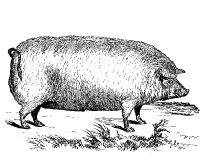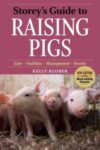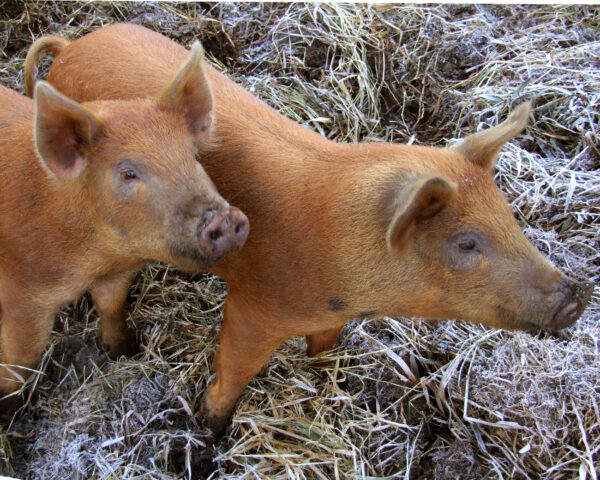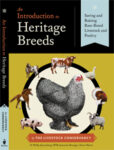
Breed Facts
Status:
Recovering
Use:
Meat
Adult Weight:
Male & Female – 500–600 lbs.
Temperament:
Docile, Active
Experience Level:
Beginner
Note:
Do not do well in confinement; may be used for Bacon, Loin, Chops, Roasts, Ham, Bacon, Sausage/Ground and other retail cuts.
TAMWORTH PIG
Long, lean, and athletic, the Tamworth might be the most direct descendant of Northern Europe’s native pig stock. There is historic documentation that some of the breed’s ancestors were now extinct Irish pigs known as “Irish Grazers.” In 1812, Sir Robert Peel, (Prime Minister of the UK between 1834-1835 and 1841-1846) imported Irish Grazers to his farm in Tamworth, and the breed takes its name from the village of Tamworth in Staffordshire.
Peel is reported to have crossed these Irish pigs with local pigs of the counties of Stafford, Warwick, Leicester, and Northampton. Prior to 1815, grizzly, dark red pigs were found largely in these Midland counties. In this region, there were dense forests of oak and beech trees where the pigs foraged in the autumn and winter. The Tamworth is believed to most closely resemble the original European forest swine breeds.
The Tamworth pig was standardized during the early to mid-1800s, becoming uniform in type. Their standardizing was accomplished by careful selection, breeding, and management and it is unlikely that other breeds have been used to any extent in their improvement – although Tamworths have been used in the development of other breeds.
In 1885, the Tamworth was recognized as a breed by the Royal Agricultural Society in 1885 and fell under the authority of the National Pig Breeders’ Association of Great Britain. In 1887, they were given First Honors at the Royal Agricultural Society’s show in competition with other large breeds. However, the breed soon fell out of favor and remained known only in some local districts until around 1877 when bacon-type hogs were in demand again.
Tamworth pigs were first imported to North America by Thomas Bennett of Rossville, IL in 1882. Many more Tamworths were imported into Canada after 1888. The American Tamworth Swine Record Association was founded in 1887 with national headquarters in Ames, IA. In Canada, the Tamworth was admitted to the Dominion Swine Breeders Association Herd Book in 1893.
The characteristics of the Tamworth reflect the breed’s centuries of selection for outdoor life. These pigs were expected to find their own food, especially acorns and mast in oak and beech forests. Long heads and impressive snouts enable them to be efficient foragers. Long, strong legs and sound feet give Tamworth pigs the ability to walk for considerable distances. Ginger-red coats make the pigs adaptable to a variety of climates and protect them from sunburn. Tamworths have an active intelligence and an agreeable disposition. Sows are prolific, able to produce and care for large litters, and are protective mothers. The piglets are vigorous and often have 100% survivability. Both sexes of this breed reach a mature weight of 500-600 lbs.
The Tamworth was traditionally considered a “bacon” breed, meaning that the pigs thrived on low-energy foods but grew slowly. They produced meat and bacon that was lean and fine-grained. The breed has an excellent carcass yield of up to 70% because their fine bones create more productive meat-to-bone ratios for finished meat products. They do not like to be confined to small areas, so they do not do well in commercial production situations.
They are a hardy breed that loves being active, and they can survive in adverse weather, but they do not deal as well in the summer. Tamworths have a thick, coarse coat but when they are molting they are susceptible to sunburn, so they need suitable housing and available mud to protect their skin and keep them cool.
They have good dispositions, are social and like being around other pigs, and are a docile breed overall. This is a good breed for beginners and worth saving.
Did you know:
History shapes breed identity and purpose. It also helps inform heritage breed conservation. The Livestock Conservancy documents these histories for each livestock and poultry breed we work with. Love History? Join today at Membership & Subscribers – The Livestock Conservancy for as little as $4 monthly.
You may be interested in…

Storey’s Guide to Raising Pigs
– Kelly Klober
$19.95
An Introduction to Heritage Breeds
– D. Phillip Sponenberg, Jeannette Beranger. Alison Martin
$19.95


